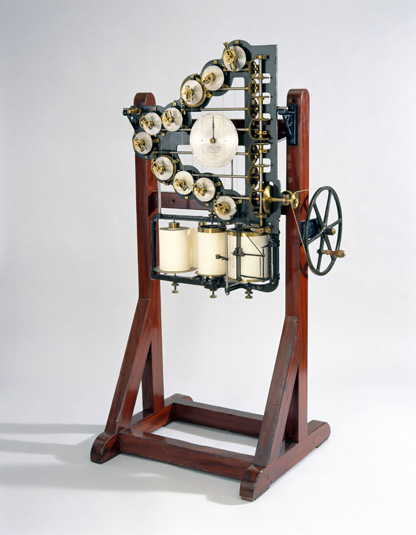A Computer to Disprove Evolution?
September 15, 2014
New York, N.Y.
If there is an annus mirabilis in the history of digital computing, it is the year 1936 (plus or minus a year or so, and hence technically anni mirabiles). It was in 1936 that Turing published his paper on computability, 1935 that Claude Elwood Shannon wrote his master's thesis that showed the equivalency between switching circuits and Boolean algebra, 1935–38 that Konrad Zuse built his first computer in his parent's apartment in Berlin, 1937 that Howard Aiken presented a concept to IBM that was to become the Harvard Mark I, and also in 1937 that George Stibitz wired up some relays on his kitchen table that added binary numbers and led to the Bell Labs Model 1 Complex Calculator.
This is not to say that nothing of interest happened prior to 1936! That period includes Charles Babbage's Difference Engine and Analytical Engine, and also a rich history of analog devices, which I find particularly interesting.
One unusual special-purpose analog computer is the Tide-Predicting Machine developed by William Thomson (Lord Kelvin) in the 1860s and 1870s. The Tide-Predicting Machine incorporates a very clever mechanism to sum together multiple sine curves and plot the result on a roll of paper. These sine curves are the components of the pattern of the rise and fall of tides at a particular seaport, and are based on an harmonic analysis of historical tidal data.

Such a machine is interesting from a technical vantage point, and it obviously has commercial, scientific, and mathematical applications. The technique that William Thomson developed is still being used today, although the calculations are performed on digital computers.
But there was another reason why Thomson had become interested in the tides:
At the time, William Thomson was involved in a controversy over the age of the Earth. Thomson used thermodynamic principles to argue that the Earth was only 20 to 40 million years old, and hence not nearly old enough for evolution to occur as Charles Darwin had described the process in The Origin of Species (1859). Thomson's research into the tides was part of an attempt to quantify tidal retardation and show that the Earth appeared to be geologically older than it actually was.
In that sense, the Tide-Predicting Machine also played an historical role as an armament in the 19th-century Darwin Wars.
Recently, the good folks who run Code on the Beach graciously allowed me to give a little talk on the Tide-Predicting Machine, and on August 8, 2014 they recorded my presentation. It's about 57 minutes in length and includes a visual simulation of the machine:
One of my long-term projects is a book about the history, science, and mathematics of the Tide-Predicting Machine, tentatively entitled Computer of the Tides: Lord Kelvin's Machine to Disprove Evolution. The book still requires a patient and enthusiastically supportive publisher.